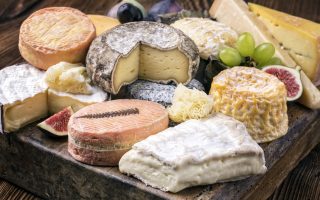Autumn – Mushroom Season in the Lot
Mushroom Madness by Sarah Weston
As the long hot summers draw to a close, and the mists in the valleys rise bringing rain and the coolness of autumn, the towns empty and the children return to school, the locals prepare themselves for the mushroom season. Although the season is relatively short, lasting about a month, it is an important part of the calendar, which brings great excitement. It is something taken very seriously. When you find a mushroom, it is like finding a ‘Louis D’or’. People go to extremes to find as many as possible, to last them the year through. It has been known for people to take a week off work, when the season begins, to gather as many as they can. A good crop of mushrooms can appear when the soil becomes sodden after a storm. Locals begin looking for edible fungi from the middle of August onwards. One summer, our neighbour found two kilos on the day of our village fete, the 15th August. Everyone has their own myths on finding wild mushrooms, but many are reluctant to share their knowledge with anyone, not even old friends.
The French are strong believers that astrology influences their everyday lives, it is generally known that an old moon brings an abundance of mushrooms. People say they appear three, six and twelve days after a full moon. Generally, they are found in chestnut woodlands and around oak and chestnut trees. Some people follow the tracks of wild animals, as mushrooms generally push through on paths and tracks. Knowledge of where and how to find mushrooms are passed on from generation to generation. A popular topic for discussion, round a table after a meal may turn to the subject of ‘mushrooms’. The French can talk endlessly on this subject. It’s ‘one for all and all for one’ during this season, everybody’s well known haunts are clenched well to their chest. Some of the locals, if they have found a plentiful supply, sell them at the local markets. Retired or people on their day off, may come to the hills and fill their baskets with a good gathering, this is where the ‘mushroom wars’ begins.
The French are just as protective about where they find their mushrooms as the land they find them on. A sign that the mushrooms are pushing is when cars can be seen parked along the side of the road. People scavenge the tracks, with their Laguiole knives in one hand and a basket or carrier bag in the other. Usually, these people come from the town or over the river in the Aveyron, as their cars wear a ’12’ number plate. The locals are never very happy with this arrangement, especially if they have been collecting them on their land. Most of the country land is privately owned in France. Often people place barriers, or put ‘Propriété Privée’ across their land. This works for some folk that obey and respect the command, whilst others do not. This is where it turns nasty. Property-owners have the right to confiscate their findings. Notes are left on the windscreens stating that if the car is seen parked here again; its tyres will be slashed. Finding mushrooms is a fun and enjoyable pastime if you abide by the rules of the countryside and are friendly to your neighbour.
Every newcomer to mushroom finding is not a novice for long. Once you have collected a few kilos and savoured their nutty flavour, nothing will stop you looking. Come rain or shine you’ll be in the woods walking up and down tracks, paths and woodlands seeking out specimens to fill your basket with. Soon the places where you look will become your favourite haunts where you will always go to look first. These places will become as familiar as the back of your hand, some you will give a name to. If the mushrooms are here, this will be a good sign that they pushing up in other parts of the woods. Being a keen horse rider, I used to love riding my horse when the cèpes were out, for I was high up and could spot exactly where they were.
Once a basket has been collected, you will need to know which varieties are good to eat and those that are poisonous. This is very important, a mushroom may look good to eat, but it may be toxic. Apart from all the books you can buy on mushrooms and fungi, a good way to check whether your findings are edible is to show the basket to a neighbour or a local, someone who has had a long experience in finding and eating wild mushrooms. We were lucky, when we started collecting mushrooms, we would take our baskets down to an eighty-year-old neighbour and she would sort them out, just throwing out the inedible mushrooms. Sometimes, we thought she put the best tasting ones to one side, and once we had gone, took them to eat for herself! If you do not have a neighbour or someone you can ask, most pharmacies in the season put up posters in their windows showing all the edible and poisonous fungi, this poster is free for everyone to take. Mushrooms can also be taken into pharmacies to check whether they are good to eat or not.
There are several different types of edible fungi all appearing at different times of the season, each having a name, different character and taste. A sight to see is a green field covered in white horse mushrooms, as small as a golf ball and as big as a dinner plates. Mushrooms are not all the same shape and can vary in size, the chanterelle is orange and delicate with a bell like top and can be found in the woodlands. Virgine is a small flat white mushroom, which is not edible but locals say it will mark the spot where the cèpe comes later. The cèpe is one of the most sought-after mushrooms and has a reputation worldwide as one of life’s delicacies. The cèpe is very distinctive. In England it sometimes is called a ‘penny-bun’, in Italy, a ‘porcini’. Its brown appearance remains brown giving it a nutty taste once it has been cooked. More varieties can be found in the woodlands that are perfectly edible and good to eat. Never pick a mushroom if you are not certain what variety it is, because some are very poisonous.
Searching for mushrooms can be take up a lot of time and energy, but at the same time can keep you fit and trim, walking is necessary to burn all those calories off, after a meal with the neighbours. In France, a popular way to cook cêp is with potatoes, parsley and garlic and is eaten with the meat course. There are three key stages in mushroom hunting, searching, preparing and the best of all devouring them with a nice glass of wine, by a glowing log fire. The last stage is the most rewarding of all! Like with all raw food, mushrooms have to be cleaned thoroughly so the soil can be removed. Place some cold water a bowl, and moisten some kitchen roll to lightly wipe clean each mushroom. If the soil is difficult to clean away, you will have to rinse well with more water, try to avoid this if possible, as they soak up water very easily, and become soggy when cooked. After cleaning, chop up the large ones into strips, but leave the small ones whole so as not to lose their flavour. If there are more mushrooms than needed, they can be placed in bags and frozen, that way they will be a plentiful supply to last throughout the year. This is worth doing, as the mushroom season is relatively short. Local housewives use a whole range of preserving techniques. Kilner jars are popularly used on the continent, they are not only useful in the containing of a variety of homemade produce, but look good as a kitchen decoration. For the mushrooms to keep fresh, the jars have to be sterilized first. Mushrooms can also be dried, to dry them, place them on a tray in the oven on a low heat for about six hours, by then they should become very dry. Alternatively, if it’s a dry autumn, they can be dried ‘nature’s way’ out in the sun. After drying the mushrooms can be placed in an airtight jar and stored until used.
Mushrooms are very versatile; they can be used for a wholesome snack, or as a dish in a gastronomic meal. A cêp omelette is perhaps the best way of savouring the flavour. Mushrooms blend well with any dish; chefs generally mix them in with sautéed potatoes to give the dish a nutty bite. The same is for every dish mushrooms accompany, whether it is a traditional roast Sunday lunch, served on their own, or mixed in with stuffing, to rich and luxuriant taste. Mushrooms are one of life’s little luxuries – a gift from nature that are too good not to try; once you have savoured their unique flavour, a passion for finding and eating mushrooms will be yours forever.
© Sarah Weston
Share to: Facebook Twitter LinkedIn Email
More in aveyron, children, cooking, schools, summer, villages, wine
Leave a reply
Your email address will not be published. Required fields are marked *



